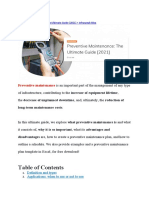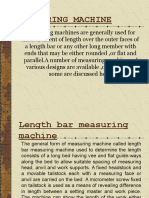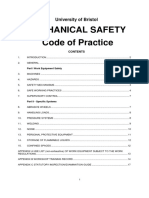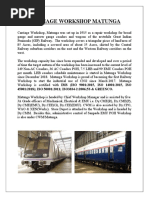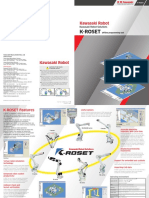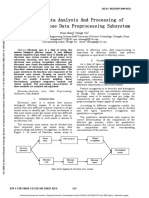0 ratings0% found this document useful (0 votes)
413 viewsBathtub Curve
Bathtub Curve
Uploaded by
Harsh GuptaThe document discusses the bathtub curve model, which demonstrates failure rates of products over their lifetime. The bathtub curve shows three phases: (1) an initial high failure rate due to design/manufacturing issues, (2) a useful life with constant failure rate due to random chance, and (3) an increasing failure rate due to wear and deterioration. This applies to both non-repairable items, where reliability is survival probability, as well as repairable items, where reliability is the failure rate. The bathtub curve provides insight into how failures change over the lifetime of a product or system.
Copyright:
© All Rights Reserved
Available Formats
Download as PPTX, PDF, TXT or read online from Scribd
Bathtub Curve
Bathtub Curve
Uploaded by
Harsh Gupta0 ratings0% found this document useful (0 votes)
413 views9 pagesThe document discusses the bathtub curve model, which demonstrates failure rates of products over their lifetime. The bathtub curve shows three phases: (1) an initial high failure rate due to design/manufacturing issues, (2) a useful life with constant failure rate due to random chance, and (3) an increasing failure rate due to wear and deterioration. This applies to both non-repairable items, where reliability is survival probability, as well as repairable items, where reliability is the failure rate. The bathtub curve provides insight into how failures change over the lifetime of a product or system.
Original Title
BATHTUB CURVE.pptx
Copyright
© © All Rights Reserved
Available Formats
PPTX, PDF, TXT or read online from Scribd
Share this document
Did you find this document useful?
Is this content inappropriate?
The document discusses the bathtub curve model, which demonstrates failure rates of products over their lifetime. The bathtub curve shows three phases: (1) an initial high failure rate due to design/manufacturing issues, (2) a useful life with constant failure rate due to random chance, and (3) an increasing failure rate due to wear and deterioration. This applies to both non-repairable items, where reliability is survival probability, as well as repairable items, where reliability is the failure rate. The bathtub curve provides insight into how failures change over the lifetime of a product or system.
Copyright:
© All Rights Reserved
Available Formats
Download as PPTX, PDF, TXT or read online from Scribd
Download as pptx, pdf, or txt
0 ratings0% found this document useful (0 votes)
413 views9 pagesBathtub Curve
Bathtub Curve
Uploaded by
Harsh GuptaThe document discusses the bathtub curve model, which demonstrates failure rates of products over their lifetime. The bathtub curve shows three phases: (1) an initial high failure rate due to design/manufacturing issues, (2) a useful life with constant failure rate due to random chance, and (3) an increasing failure rate due to wear and deterioration. This applies to both non-repairable items, where reliability is survival probability, as well as repairable items, where reliability is the failure rate. The bathtub curve provides insight into how failures change over the lifetime of a product or system.
Copyright:
© All Rights Reserved
Available Formats
Download as PPTX, PDF, TXT or read online from Scribd
Download as pptx, pdf, or txt
You are on page 1of 9
RELIABILITY ENGINEERING
BATHTUB CURVE
Made by : Harsh Gupta
Roll No. : K018
What is Bathtub curve?
• The bathtub curve is a type of model
demonstrating the likely failure rates
of technologies and products.
• Over a certain product lifetime, the
bathtub curve shows how many units
might fail during any given phase of a
three-part timeline.
Repairable and Non-Repairable Items
• Non- Repairable Items –
For a non-repairable item such as a light bulb, a transistor, a rocket motor or an
unmanned spacecraft, reliability is the survival probability over the item’s
expected life, or for a period during its life, when only one failure can occur.
During the item’s life the instantaneous probability of the first and only failure is
called the hazard rate. Life values such as the mean life or mean time to failure
(MTTF), or the expected life by which a certain percentage might have failed
(percentile life), are other reliability characteristics that can be used.
Repairable and Non-Repairable Items
• Repairable Items –
For items which are repaired when they fail, reliability is the probability that
failure will not occur in the period of interest, when more than one failure can
occur. It can also be expressed as the rate of occurrence of failures (ROCOF),
which is sometimes referred as the failure rate (usually denoted as λ).
Repairable system reliability can also be characterized by the mean time between
failures (MTBF), but only under the particular condition of a constant failure rate.
It is often assumed that failures do occur at a constant rate, in which case the
failure rate λ = (MTBF)-1.
Bathtub curve for Non-Repairable Items
Bathtub curve for Non-Repairable Items
• Zone 1 is the infant mortality period is characterized by an initially high failure rate. This is
normally the result of poor design, the use of substandard components, or lack of adequate controls
in the manufacturing process. Early failures can be eliminated by a “burn in” period.
• Zone 2, the useful life period, is characterized by an essentially constant failure rate. This is the
period dominated by chance failures. Chance failures are those failures that result from strictly
random or chance causes. They cannot be eliminated by either lengthy burn-in periods or good
preventive maintenance practices.
• Zone 3, the wear out period, is characterized by an increasing failure rate as a result of equipment
deterioration due to age or use. For example: mechanical components such as transmission bearings
will eventually wear out and fail, regardless of how well they are made. The only way to prevent
failure due to wear out is to replace or repair the deteriorating component before it fails.
• The combined effect generates the so-called bathtub curve. This shows an initial decreasing hazard
rate or infant mortality period, an intermediate useful life period and a final wear out period. Death
is a good analogy to failure of a non-repairable system, and the bathtub curve model is similar to
actuarial statistical models.
Bathtub curve for Repairable Items
Bathtub curve for Repairable Items
• The failure rates (or ROCOF) of repairable items can also vary with time, and important
implications can be derived from these trends.
• A constant failure rate (CFR) is indicative of externally induced failures, as in the constant
hazard rate situation for non-repairable items. A CFR is also typical of complex systems subject
to repair and overhaul, where different parts exhibit different patterns of failure with time and
parts have different ages since repair or replacement.
• Repairable systems can show a decreasing failure rate (DFR) when reliability is improved by
progressive repair, as defective parts which fail relatively early are replaced by good parts. ‘Burn
in’ is applied to electronic systems, as well as to parts, for this purpose.
• An increasing failure rate (IFR) occurs in repairable systems when wearout failure modes of
parts begin to predominate.
• The pattern of failures with time of repairable systems can also be illustrated by use of the
bathtub curve, but with the failure rate (ROCOF) plotted against age instead of the hazard rate.
You might also like
- Productivity and Reliability-Based Maintenance Management, Second EditionFrom EverandProductivity and Reliability-Based Maintenance Management, Second EditionNo ratings yet
- Assignment 2 (Vishnubhai Jayeshbhai Panchal 202285861)Document8 pagesAssignment 2 (Vishnubhai Jayeshbhai Panchal 202285861)Ashish VoraNo ratings yet
- Unit 1 Principles and Practices of Maintenance Planning KVNDocument23 pagesUnit 1 Principles and Practices of Maintenance Planning KVNVenkadeshwaran KuthalingamNo ratings yet
- Maintenance EngineeringDocument67 pagesMaintenance EngineeringV.Muthu KumarNo ratings yet
- 9 Types of Maintenance - How To Choose The Right Maintenance StrategyDocument10 pages9 Types of Maintenance - How To Choose The Right Maintenance Strategydejan100% (1)
- Lecture No 12 MaintainabilityDocument25 pagesLecture No 12 MaintainabilityAltamash MunirNo ratings yet
- English Plus 2 - Student 39 S Book PDFDocument125 pagesEnglish Plus 2 - Student 39 S Book PDFTatjana Pop-AntoskaNo ratings yet
- RJS Relibility PPT-1Document61 pagesRJS Relibility PPT-1Ram Janm SinghNo ratings yet
- Unit IV - 1 PDFDocument43 pagesUnit IV - 1 PDFsudarsan kingNo ratings yet
- Maintenance Engineering AssignmentDocument2 pagesMaintenance Engineering AssignmentZiki EphraimNo ratings yet
- Is 4002 Maintainability EngineeringDocument118 pagesIs 4002 Maintainability Engineeringraj KumarNo ratings yet
- Section 1: Introduction To ReliabilityDocument30 pagesSection 1: Introduction To ReliabilitysukhmeetNo ratings yet
- LEC1 Maintenance DefinitionDocument31 pagesLEC1 Maintenance DefinitionSaba ShaikhNo ratings yet
- ISME MannualDocument13 pagesISME MannualjaxshahNo ratings yet
- Major Project Report On Water Cum Air Cooler (By Nikhil Kumar 7074021ME)Document13 pagesMajor Project Report On Water Cum Air Cooler (By Nikhil Kumar 7074021ME)somya samalNo ratings yet
- Engineering MaintenanceDocument5 pagesEngineering Maintenanceapi-3723333100% (1)
- Maintainence Notes by Er Parmod BhardwajDocument135 pagesMaintainence Notes by Er Parmod Bhardwajparmod99100% (1)
- Mechanical Fem Syllabus PDFDocument2 pagesMechanical Fem Syllabus PDFmsckoneruNo ratings yet
- Design For Reliability PDFDocument44 pagesDesign For Reliability PDFMohamed ZafatiNo ratings yet
- Motion Analysis: Seminar OnDocument37 pagesMotion Analysis: Seminar OnNitta MallikNo ratings yet
- Design For X' (DES 508) : Dr. Arivazhagan. A IIITD&M, KancheepuramDocument67 pagesDesign For X' (DES 508) : Dr. Arivazhagan. A IIITD&M, KancheepuramKeerthi SagarNo ratings yet
- Reliability and MaintenanceDocument77 pagesReliability and MaintenanceMitesh SharmaNo ratings yet
- Lecture-1 PPT (Introduction To Maintenance)Document44 pagesLecture-1 PPT (Introduction To Maintenance)kassawNo ratings yet
- Integrating Reliability-Centered Maintenance With Cost Optimization e Application in Plant of Hard Chrome PlatingDocument8 pagesIntegrating Reliability-Centered Maintenance With Cost Optimization e Application in Plant of Hard Chrome PlatingDaniloNo ratings yet
- Reliability Engineering: Kartik Gupta 2K13/PE/016Document15 pagesReliability Engineering: Kartik Gupta 2K13/PE/016Kartik GuptaNo ratings yet
- Reliability Systems: Emm5614 Maintenance Manufacturing ManagementDocument23 pagesReliability Systems: Emm5614 Maintenance Manufacturing ManagementAnas AhmedNo ratings yet
- Belts, Ropes and Chain DrivesDocument29 pagesBelts, Ropes and Chain Drivesnaveen_kumar29173017100% (1)
- It Is ConsiderationDocument17 pagesIt Is ConsiderationTulasabai JaiswalNo ratings yet
- Unit-V: Reliability, Reliability Centered Maintenance (RCM)Document32 pagesUnit-V: Reliability, Reliability Centered Maintenance (RCM)Joel ChittiproluNo ratings yet
- 2018PPE8005 - Design of V Belt (Part 2)Document15 pages2018PPE8005 - Design of V Belt (Part 2)Kartik AggarwalNo ratings yet
- Module 5 Powder Metallurgy & Injection MouldingDocument72 pagesModule 5 Powder Metallurgy & Injection MouldingMaheshNo ratings yet
- Reliability: Federal University of Technology OwerriDocument105 pagesReliability: Federal University of Technology OwerridialauchennaNo ratings yet
- ReliabilityDocument8 pagesReliabilityTri Yudha SetiawanNo ratings yet
- Chapter - Five: Reliability, Availability and MaintainabilityDocument25 pagesChapter - Five: Reliability, Availability and MaintainabilityfekadeNo ratings yet
- Reliability: Federal University of Technology OwerriDocument105 pagesReliability: Federal University of Technology Owerridialauchenna100% (2)
- Maintenance and Reliability: © 2011 Pearson Education, Inc. Publishing As Prentice HallDocument55 pagesMaintenance and Reliability: © 2011 Pearson Education, Inc. Publishing As Prentice HallAle MariaNo ratings yet
- Belt Drive: Prof. H. D. Mhatre 1Document22 pagesBelt Drive: Prof. H. D. Mhatre 1PHOOL KUMAR PATELNo ratings yet
- M4. Bathtub CurveDocument29 pagesM4. Bathtub CurveElidad SukardiNo ratings yet
- Preventive Maintenance2Document22 pagesPreventive Maintenance2Shivaji ThubeNo ratings yet
- 6-Types of Cost-23-08-2021 (23-Aug-2021) Material - I - 23-Aug-2021 - MEE1014 - Elements - of - Cost - NewDocument67 pages6-Types of Cost-23-08-2021 (23-Aug-2021) Material - I - 23-Aug-2021 - MEE1014 - Elements - of - Cost - NewSahil KumarNo ratings yet
- Introduction To CNC Programming and Industrial RoboticsDocument50 pagesIntroduction To CNC Programming and Industrial RoboticstaridanNo ratings yet
- Maint W Reliability ConceptDocument20 pagesMaint W Reliability ConceptAbiodun IloriNo ratings yet
- Maintenance Engineering (CH: 2,0) : Instructors: Dr. M. Zeeshan Zahir Engr. Adnan RasheedDocument25 pagesMaintenance Engineering (CH: 2,0) : Instructors: Dr. M. Zeeshan Zahir Engr. Adnan RasheedMinhaj UllahNo ratings yet
- The QFD and Quality CircleDocument13 pagesThe QFD and Quality Circleramit77No ratings yet
- Measuring MachineDocument19 pagesMeasuring Machinegopir28No ratings yet
- ME1012 Maintenance Engineering Study MaterialsDocument37 pagesME1012 Maintenance Engineering Study Materialssathurvedha50% (2)
- Solid Ground CuringDocument11 pagesSolid Ground CuringParth Modi100% (4)
- MANF 5317 Maintenance of Machinery Lecture NotesDocument76 pagesMANF 5317 Maintenance of Machinery Lecture Notesrobel metikuNo ratings yet
- ABC Hospital - SolutionDocument12 pagesABC Hospital - SolutionMayank Patel100% (1)
- Maintenance and Maintenance Management Systems in AccommodationDocument11 pagesMaintenance and Maintenance Management Systems in AccommodationHoh Pui KeiNo ratings yet
- Getahu Final PDocument72 pagesGetahu Final Pyoseph GetnetNo ratings yet
- Assignment Presentation II Reliability: Goutham DecemberDocument8 pagesAssignment Presentation II Reliability: Goutham Decembergoutham ramNo ratings yet
- Topic 5 Straightness and Flatness TestingDocument31 pagesTopic 5 Straightness and Flatness TestingkipkorirdennisNo ratings yet
- MimDocument8 pagesMimBiniam Nega100% (2)
- ME6012 Maintenance EngineeringDocument8 pagesME6012 Maintenance EngineeringBhuvanesh KumarNo ratings yet
- Mech Safety PoDocument19 pagesMech Safety PoJackson GonçalvesNo ratings yet
- Operations Management: Maintenance and ReliabilityDocument35 pagesOperations Management: Maintenance and ReliabilityfatkhiNo ratings yet
- Generic Terms of Reference For ESIADocument11 pagesGeneric Terms of Reference For ESIADragoljub DjordjevicNo ratings yet
- Minimum Learing Material - MaintenanceDocument144 pagesMinimum Learing Material - MaintenanceSaravanan Ak100% (1)
- Chapter 4Document37 pagesChapter 4kirubel AlemuNo ratings yet
- MTBFDocument4 pagesMTBFmithileshkumareicNo ratings yet
- Assume The Following Investment Alternatives Which One Is The Best?Document35 pagesAssume The Following Investment Alternatives Which One Is The Best?Harsh GuptaNo ratings yet
- Mukesh Patel School of Technology Management & EngineeringDocument3 pagesMukesh Patel School of Technology Management & EngineeringHarsh GuptaNo ratings yet
- Security Analysis: Chapter - 1Document47 pagesSecurity Analysis: Chapter - 1Harsh GuptaNo ratings yet
- Return and Risk On Two Assets PortfolioDocument24 pagesReturn and Risk On Two Assets PortfolioHarsh GuptaNo ratings yet
- Risk and ReturnDocument27 pagesRisk and ReturnHarsh GuptaNo ratings yet
- MIP Student Guidelines 2020Document34 pagesMIP Student Guidelines 2020Harsh GuptaNo ratings yet
- Ayush Agarwal: Study of Maintenance of ICF/RCF Coaches of Indian RailwaysDocument16 pagesAyush Agarwal: Study of Maintenance of ICF/RCF Coaches of Indian RailwaysHarsh GuptaNo ratings yet
- New Doc 2019-05-03 10.55.09Document20 pagesNew Doc 2019-05-03 10.55.09Harsh GuptaNo ratings yet
- Harsh Gupta: Study of Maintenance of ICF/RCF Coaches of Indian RailwaysDocument16 pagesHarsh Gupta: Study of Maintenance of ICF/RCF Coaches of Indian RailwaysHarsh GuptaNo ratings yet
- Carriage Workshop MatungaDocument7 pagesCarriage Workshop MatungaHarsh GuptaNo ratings yet
- 14 - Chapter 4Document28 pages14 - Chapter 4Harsh GuptaNo ratings yet
- To Whom So Ever It May Concern: This Is To Certify That Mr. Ayush Agarwal, Student ofDocument1 pageTo Whom So Ever It May Concern: This Is To Certify That Mr. Ayush Agarwal, Student ofHarsh GuptaNo ratings yet
- Maintenance of Passenger Coaches - Saurabh PrasadDocument64 pagesMaintenance of Passenger Coaches - Saurabh PrasadHarsh GuptaNo ratings yet
- Executive Summary Report-K002Document22 pagesExecutive Summary Report-K002Harsh GuptaNo ratings yet
- % Expenditure, Commission, Salary, & Bonus Problems Youtube Lecture HandoutsDocument2 pages% Expenditure, Commission, Salary, & Bonus Problems Youtube Lecture HandoutsHarsh GuptaNo ratings yet
- Ratio, Proportion and Percentages Formulas and TricksDocument3 pagesRatio, Proportion and Percentages Formulas and TricksHarsh GuptaNo ratings yet
- Successive %-3 Type of Problems Youtube Lecture Handouts: ExamraceDocument3 pagesSuccessive %-3 Type of Problems Youtube Lecture Handouts: ExamraceHarsh GuptaNo ratings yet
- IntroductionDocument5 pagesIntroductionHarsh GuptaNo ratings yet
- Sequences, Progressions, Series, Means and AveragesDocument2 pagesSequences, Progressions, Series, Means and AveragesHarsh GuptaNo ratings yet
- Venn Diagram YouTube Lecture HandoutsDocument4 pagesVenn Diagram YouTube Lecture HandoutsHarsh GuptaNo ratings yet
- Percentage (Aptitude) Youtube Lecture Handouts For Competitive ExamsDocument6 pagesPercentage (Aptitude) Youtube Lecture Handouts For Competitive ExamsHarsh GuptaNo ratings yet
- Work Rate Problems YouTube Lecture HandoutsDocument7 pagesWork Rate Problems YouTube Lecture HandoutsHarsh GuptaNo ratings yet
- Stats DataDocument1,082 pagesStats DataHarsh GuptaNo ratings yet
- Sump To Overhead Tank ControllerDocument5 pagesSump To Overhead Tank ControllerkowshickNo ratings yet
- Edu Cat en v5f FF v5r16 Lesson06 ToprintDocument94 pagesEdu Cat en v5f FF v5r16 Lesson06 ToprintRabiBasuNo ratings yet
- HardwareDocument12 pagesHardwaremussindojunior7No ratings yet
- Develop Understanding of The Ethiopian Financial System and Markets OSDocument54 pagesDevelop Understanding of The Ethiopian Financial System and Markets OSNigus AyeleNo ratings yet
- Dahua HD Mini IR Waterproof Fixed Network Camera Quick Start Guide (Web 3.0) V1.0.0 20141215Document15 pagesDahua HD Mini IR Waterproof Fixed Network Camera Quick Start Guide (Web 3.0) V1.0.0 20141215shadyghanemNo ratings yet
- Configure Ipv6 - Over Is-IsDocument8 pagesConfigure Ipv6 - Over Is-IsSorabh MohindruNo ratings yet
- AutoCAD Interface OverviewDocument1 pageAutoCAD Interface OverviewMarc BuenaflorNo ratings yet
- Jeffrey e Young Reinventing Your Lifepdf CompressDocument182 pagesJeffrey e Young Reinventing Your Lifepdf CompressFady RamsisNo ratings yet
- Page Builder - Elementor (PDFDrive) .Es - enDocument17 pagesPage Builder - Elementor (PDFDrive) .Es - enKhushboo MathurNo ratings yet
- Kawasaki K-ROSET Offline Programming ToolDocument2 pagesKawasaki K-ROSET Offline Programming Toolsrinivasan0% (1)
- CWT5018 Installation Manual - enDocument5 pagesCWT5018 Installation Manual - engogo gNo ratings yet
- Wan Mohamed Ilham Bin Wan Roshdan - 2022949545 - Final Report - Ubm599Document67 pagesWan Mohamed Ilham Bin Wan Roshdan - 2022949545 - Final Report - Ubm5992022949545No ratings yet
- Veeam SAP Avilability GuideDocument64 pagesVeeam SAP Avilability Guidemummy206100% (1)
- Tinjauan Yuridis Mengenai Pengawasan Terhadap Pedoman Perilaku Penyiaran Platform Media Sosial Di IndonesiaDocument19 pagesTinjauan Yuridis Mengenai Pengawasan Terhadap Pedoman Perilaku Penyiaran Platform Media Sosial Di IndonesiaMuhammad RakhaNo ratings yet
- DSTL QuantumDocument134 pagesDSTL QuantumVipin MauryaNo ratings yet
- Precommissioning Check LED Signal DocumentDocument10 pagesPrecommissioning Check LED Signal DocumentVikas SrivastavNo ratings yet
- Kaspersky Security Awareness: Computer-Based Training Programs For All Organizational LevelsDocument8 pagesKaspersky Security Awareness: Computer-Based Training Programs For All Organizational LevelsmeimNo ratings yet
- Chapter 1: Further Sequential Logic Systems Synchronous CountersDocument34 pagesChapter 1: Further Sequential Logic Systems Synchronous CountersKKK enNo ratings yet
- Crash LogDocument2 pagesCrash Logfortnite Leake iraniNo ratings yet
- A64 Datasheet V1.1 PDFDocument64 pagesA64 Datasheet V1.1 PDFpedisoj465No ratings yet
- Orthogonal Transforms For Digital Signal ProcessingDocument5 pagesOrthogonal Transforms For Digital Signal ProcessingCezara RasinarNo ratings yet
- Fundamentals of Algorithms - CS502 HandoutsDocument4 pagesFundamentals of Algorithms - CS502 HandoutsPayal SharmaNo ratings yet
- ds36x8 Er Battlecard A4Document5 pagesds36x8 Er Battlecard A4LeandroGoulartNo ratings yet
- Lokasi: Gudang MMTC No. Gambar Nama Barang Jumlah Harga Yang Ditawarkan 1. Kepala Charger RP 2.500Document15 pagesLokasi: Gudang MMTC No. Gambar Nama Barang Jumlah Harga Yang Ditawarkan 1. Kepala Charger RP 2.500Kevin TjanNo ratings yet
- Jenna Rainey - Color Wheel Guide - YouTubeDocument5 pagesJenna Rainey - Color Wheel Guide - YouTubeMarina Lenza100% (1)
- English File: Grammar, Vocabulary, and PronunciationDocument4 pagesEnglish File: Grammar, Vocabulary, and PronunciationEszter CsertánNo ratings yet
- Ret Screen Error LogDocument6 pagesRet Screen Error LogIgnatius Ir'awan' HermantoNo ratings yet
- Several Data Analysis and Processing of Electronic Nose Data Preprocessing SubsystemDocument4 pagesSeveral Data Analysis and Processing of Electronic Nose Data Preprocessing Subsystem陈述涵No ratings yet
- Ug - Tv-Ip851wc - Tv-Ip851wic - (V1 0R)Document51 pagesUg - Tv-Ip851wc - Tv-Ip851wic - (V1 0R)Othmane RaisNo ratings yet






































